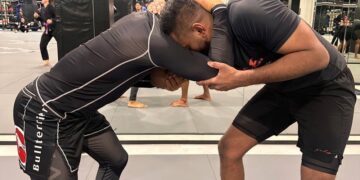
The technical development of Brazilian Jiu-Jitsu over the past couple of decades has been nothing short of astounding. BJJ is a rapidly spreading fighting style where you use grappling techniques to subdue and eventually dominate the opponent. The techniques you see from practitioners are based on a solid understanding of leverage and positioning, giving even the smallest practitioner the ability to beat many large adversaries. The reliable long-step pass is among the thousands of techniques you can use. This guard pass is our focus for today’s article, and we’ll go over the basic mechanics and application of the move.
What Is The Long Step Pass?
The long step pass has been a staple of Jiu-Jitsu’s guard passing game for decades. It came to prominence mainly in the early 2000s and was one of the central techniques of the era. Legends like Fernando “Terere” Augusto were the primary innovators of this guard-passing approach. His technical mastery, combined with his brand of dynamic BJJ, became one of the catalysts to what we see on the mats today.
In this video, the great Keenan Cornelius explains the fundamental traits and mechanics of the long step pass. For those who do not know, Keenan is regarded as one of the most successful American BJJ black belts in Jiu-Jitsu. He is a brilliant innovator and will go down in history as one of the best to ever do it. The long step pass, as mentioned, has been a favored guard passing move for years, and is typically paired with techniques like the toreando (bullfighter) and knee cut passes. What sets the long step pass apart is that it can quickly create opportunities to get past the opponent’s legs. Unlike the toreando and knee cut, where you fight force against force, the long step puts you in a situation to move towards an unoccupied space, making it that much easier to complete the guard pass. The caveat is that the technique may not be as secure as pressure-based passes, as you turn your body away instead of towards your opponent. Nevertheless, the long step guard pass is a very worthwhile move to study.
Now, let’s break down the technique step by step. Keenan mentions that the best time to go for the long step pass is when your opponent turns to their side. There are 3 basic initial grips you should strive to get: a grip on the collar, a grip on the back, or a grip near the neck. All are good options, all things considered. Enter the opponent’s guard with your lead leg forward. If you use your right leg to lead, get the initial grip using your left hand. Next, lower your base as you maintain the grip and switch your base by stepping backwards as you land on your left hip, keeping both legs extended. Doing this movement should allow you to pass the opponent’s guard instantly. The opponent will do whatever it takes to recover guard, typically going to their knees to initiate a scramble. Simply put your arm near the hip to block them from getting the inside space. From here, stabilize your position and go to side control.
Can You Do The Long Step Pass In No-Gi?
The long step pass was created with the Gi in mind, but with a bit of tweaking, you can also employ this valuable guard pass without the Gi. The initial grip is perhaps the most critical difference when doing this in No-Gi. As you know, we are not allowed to grab the shirt or rashguard in No-Gi, so we will have to do with using head control or reverse scoop to control the upper body. Use a C grip to monitor the opponent’s leg, and from here, you can do the same long step motion as previously discussed. Note that while doing the long step pass in No-Gi is viable, it is not as secure due to the lack of Gi grips.
Combining Guard Passes
As Keenan mentioned, the best way to use the long step pass (or any guard pass, for that matter) is by using it as part of a rotation of techniques. Doing this makes you unpredictable to defend against, forcing the opponent to stay on the defensive, thus making them tired.
We recommend using the knee cut, toreando, leg drag, and long step pass as a system when you want to pass standing. These are all great techniques by their own merit; combining them into a series of attacks will only amplify their effectiveness, that’s for sure.
It is a must to master these moves into a sequence so that you can attack with minimal effort. This is where drilling and flow rolling come in. Ensure you give your body enough time to internalize these movements as much as possible. Give yourself a few months of consistent effort to practice combining these techniques with little to no resistance, and slowly add counters and defenses as you go along. You should know the primary defenses to these techniques, as you’ll need to work around these when dealing with fully resisting training partners.
Choosing Your Techniques Wisely
There’s a staggering number of techniques you can choose from in Brazilian Jiu-Jitsu. The key to building a strong game is to select techniques that can be easily combined with each other. Always consider your body type, age, and even disposition when building your repertoire. You should be able to switch from one move to the next seamlessly. If a technique particularly sticks out as hard to pull off, do not hesitate to remove it for the time being. You can always adjust your game as you go up the ranks.
Conclusion
The long step pass is a staple for a reason. This is one of the most battle-tested guard passes in BJJ, and many champions of yesterday and today have used it to win high-profile matches. Whether you are a beginner or an advanced player, the long step is an excellent option to add to your Jiu-Jitsu.
You may also like this:
How To Do Standing Back Takes In BJJ
Brazilian Jiu-Jitsu is an ever-evolving martial art that flourishes on the principle of leverage and technique. This principle is evident in the myriad of escapes and defensive maneuvers that allow a practitioner to evade or…
A significant part of your time training Brazilian Jiu-Jitsu will focus off your back. The bottom game is a big part of the sport and involves using techniques to attack the opponent, as well as…
Brazilian Jiu-Jitsu is known for the many positive benefits its practitioners reap. The most common is that practitioners learn about self-defense and thus develop a strong body, experience weight loss, and boost self-confidence. While most…
Brazilian Jiu-Jitsu is a martial art that emphasizes ground fighting. One of the most fundamental elements of BJJ is the use of various sweeps to reverse the position, thereby putting you in a good spot…
In Brazilian Jiu-Jitsu, the common route towards pinning the opponent is first getting past their legs. This means that you have to pass their guard to get to their upper body. A successful guard pass…
One of the best ways to finish an opponent in BJJ is to get behind and choke them. Getting behind an opponent gives you a solid advantage as it allows you to set up different…
Regularly training Muay Thai often delivers better results than traditional gym workouts. That’s not to say resistance training at a gym doesn’t serve any purposes, but it doesn’t give you the same physical, mental, and…
As the year draws to an end, Christmas comes again in December. This time is supposed to be a month to reflect on our year, relax and catch up with old friends and family. But…
The jab is undoubtedly one of the cornerstones of striking, regardless of your chosen combat sport. Boxers, Nak Muay, and MMA fighters use the jab for a myriad of reasons, from establishing range to even…
So, you’ve been training hard for a while, maybe you’ve attended a few interclubs and now you have made the decision to fight. Competing in Muay Thai, even at an amateur level is almost a…
Very few athletes in mixed martial arts can boast a journey as remarkable as Alex “Poatan” Pereira’s. From a multiple-division kickboxing champion to becoming a two-division champion in the Ultimate Fighting Championship, despite only seven…
Soo Wei’s adventure is as eclectic as it is inspiring, it is one of true grit, from roaming Europe’s cobblestone streets to mastering Brazilian Jiu-Jitsu (BJJ), she’s Evolve MMA’s Student of the Month, not just…


































